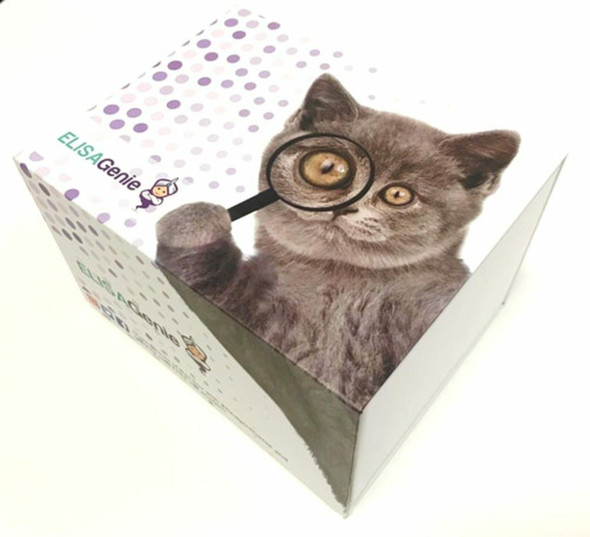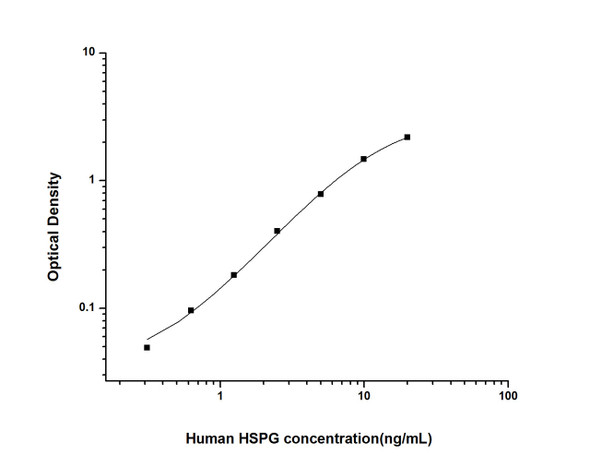Human Immunology ELISA Kits 5
Human Basement membrane-specific heparan sulfate proteoglycan core protein (HSPG2) ELISA Kit
- SKU:
- HUEB0733
- Product Type:
- ELISA Kit
- Size:
- 96 Assays
- Uniprot:
- P98160
- Range:
- 0.625-40 ng/mL
- ELISA Type:
- Sandwich
- Synonyms:
- HSPG2, PLC, HSPG, PRCAN, SJA, SJS, SJS1, Perlecan, endorepellin, domain V region, heparan sulfate proteoglycan 2, perlecan proteoglycan, PLCSchwartz-Jampel syndrome 1, chondrodystrophic myotonia,
- Reactivity:
- Human
Description
| Product Name: | Human Basement membrane-specific heparan sulfate proteoglycan core protein (HSPG2) ELISA Kit |
| Product Code: | HUEB0733 |
| Alias: | Basement membrane-specific heparan sulfate proteoglycan core protein, HSPG, Perlecan, PLC, HSPG2 |
| Uniprot: | P98160 |
| Reactivity: | Human |
| Range: | 0.625-40 ng/mL |
| Detection Method: | Sandwich |
| Size: | 96 Assay |
| Storage: | Please see kit components below for exact storage details |
| Note: | For research use only |
| UniProt Protein Function: | HSPG2: Integral component of basement membranes. Component of the glomerular basement membrane (GBM), responsible for the fixed negative electrostatic membrane charge, and which provides a barrier which is both size- and charge-selective. It serves as an attachment substrate for cells. Plays essential roles in vascularization. Critical for normal heart development and for regulating the vascular response to injury. Also required for avascular cartilage development. Defects in HSPG2 are the cause of Schwartz-Jampel syndrome (SJS1); a rare autosomal recessive disorder characterized by permanent myotonia (prolonged failure of muscle relaxation) and skeletal dysplasia, resulting in reduced stature, kyphoscoliosis, bowing of the diaphyses and irregular epiphyses. Defects in HSPG2 are the cause of dyssegmental dysplasia Silverman-Handmaker type (DDSH). The dyssegmental dysplasias are rare, autosomal recessive skeletal dysplasias with anisospondyly and micromelia. There are two recognized types: the severe, lethal DDSH and the milder Rolland-Desbuquois form. Individuals with DDSH also have a flat face, micrognathia, cleft palate and reduced joint mobility, and frequently have an encephalocoele. The endochondral growth plate is short, the calcospherites (which are spherical calcium-phosphorus crystals produced by hypertrophic chondrocytes) are unfused, and there is mucoid degeneration of the resting cartilage. |
| UniProt Protein Details: | Protein type:Secreted, signal peptide; Motility/polarity/chemotaxis; Secreted; Cell adhesion Chromosomal Location of Human Ortholog: 1p36.1-p34 Cellular Component: extracellular matrix; lysosomal lumen; extracellular space; focal adhesion; Golgi lumen; plasma membrane; extracellular region; basal lamina Molecular Function:protein C-terminus binding; protein binding; metal ion binding Biological Process: cardiac muscle development; phototransduction, visible light; extracellular matrix organization and biogenesis; glycosaminoglycan metabolic process; lipoprotein metabolic process; pathogenesis; embryonic skeletal morphogenesis; chondroitin sulfate metabolic process; extracellular matrix disassembly; glycosaminoglycan biosynthetic process; protein localization; glycosaminoglycan catabolic process; carbohydrate metabolic process; chondrocyte differentiation; angiogenesis; brain development; retinoid metabolic process; endochondral ossification Disease: Schwartz-jampel Syndrome, Type 1; Dyssegmental Dysplasia, Silverman-handmaker Type |
| NCBI Summary: | This gene encodes the perlecan protein, which consists of a core protein to which three long chains of glycosaminoglycans (heparan sulfate or chondroitin sulfate) are attached. The perlecan protein is a large multidomain proteoglycan that binds to and cross-links many extracellular matrix components and cell-surface molecules. It has been shown that this protein interacts with laminin, prolargin, collagen type IV, FGFBP1, FBLN2, FGF7 and transthyretin, etc., and it plays essential roles in multiple biological activities. Perlecan is a key component of the vascular extracellular matrix, where it helps to maintain the endothelial barrier function. It is a potent inhibitor of smooth muscle cell proliferation and is thus thought to help maintain vascular homeostasis. It can also promote growth factor (e.g., FGF2) activity and thus stimulate endothelial growth and re-generation. It is a major component of basement membranes, where it is involved in the stabilization of other molecules as well as being involved with glomerular permeability to macromolecules and cell adhesion. Mutations in this gene cause Schwartz-Jampel syndrome type 1, Silverman-Handmaker type of dyssegmental dysplasia, and tardive dyskinesia. Alternative splicing of this gene results in multiple transcript variants. [provided by RefSeq, May 2014] |
| UniProt Code: | P98160 |
| NCBI GenInfo Identifier: | 13242858 |
| NCBI Gene ID: | 3339 |
| NCBI Accession: | AAB21121.2 |
| UniProt Secondary Accession: | P98160,Q16287, Q5SZI3, Q9H3V5, |
| UniProt Related Accession: | P98160 |
| Molecular Weight: | 468,830 Da |
| NCBI Full Name: | heparan sulfate proteoglycan core protein, partial |
| NCBI Synonym Full Names: | heparan sulfate proteoglycan 2 |
| NCBI Official Symbol: | HSPG2 |
| NCBI Official Synonym Symbols: | PLC; SJA; SJS; HSPG; SJS1; PRCAN |
| NCBI Protein Information: | basement membrane-specific heparan sulfate proteoglycan core protein; perlecan proteoglycan; endorepellin (domain V region) |
| UniProt Protein Name: | Basement membrane-specific heparan sulfate proteoglycan core protein |
| UniProt Synonym Protein Names: | Perlecan; PLC |
| UniProt Gene Name: | HSPG2 |
| UniProt Entry Name: | PGBM_HUMAN |
| Component | Quantity (96 Assays) | Storage |
| ELISA Microplate (Dismountable) | 8×12 strips | -20°C |
| Lyophilized Standard | 2 | -20°C |
| Sample Diluent | 20ml | -20°C |
| Assay Diluent A | 10mL | -20°C |
| Assay Diluent B | 10mL | -20°C |
| Detection Reagent A | 120µL | -20°C |
| Detection Reagent B | 120µL | -20°C |
| Wash Buffer | 30mL | 4°C |
| Substrate | 10mL | 4°C |
| Stop Solution | 10mL | 4°C |
| Plate Sealer | 5 | - |
Other materials and equipment required:
- Microplate reader with 450 nm wavelength filter
- Multichannel Pipette, Pipette, microcentrifuge tubes and disposable pipette tips
- Incubator
- Deionized or distilled water
- Absorbent paper
- Buffer resevoir
*Note: The below protocol is a sample protocol. Protocols are specific to each batch/lot. For the correct instructions please follow the protocol included in your kit.
Allow all reagents to reach room temperature (Please do not dissolve the reagents at 37°C directly). All the reagents should be mixed thoroughly by gently swirling before pipetting. Avoid foaming. Keep appropriate numbers of strips for 1 experiment and remove extra strips from microtiter plate. Removed strips should be resealed and stored at -20°C until the kits expiry date. Prepare all reagents, working standards and samples as directed in the previous sections. Please predict the concentration before assaying. If values for these are not within the range of the standard curve, users must determine the optimal sample dilutions for their experiments. We recommend running all samples in duplicate.
| Step | |
| 1. | Add Sample: Add 100µL of Standard, Blank, or Sample per well. The blank well is added with Sample diluent. Solutions are added to the bottom of micro ELISA plate well, avoid inside wall touching and foaming as possible. Mix it gently. Cover the plate with sealer we provided. Incubate for 120 minutes at 37°C. |
| 2. | Remove the liquid from each well, don't wash. Add 100µL of Detection Reagent A working solution to each well. Cover with the Plate sealer. Gently tap the plate to ensure thorough mixing. Incubate for 1 hour at 37°C. Note: if Detection Reagent A appears cloudy warm to room temperature until solution is uniform. |
| 3. | Aspirate each well and wash, repeating the process three times. Wash by filling each well with Wash Buffer (approximately 400µL) (a squirt bottle, multi-channel pipette,manifold dispenser or automated washer are needed). Complete removal of liquid at each step is essential. After the last wash, completely remove remaining Wash Buffer by aspirating or decanting. Invert the plate and pat it against thick clean absorbent paper. |
| 4. | Add 100µL of Detection Reagent B working solution to each well. Cover with the Plate sealer. Incubate for 60 minutes at 37°C. |
| 5. | Repeat the wash process for five times as conducted in step 3. |
| 6. | Add 90µL of Substrate Solution to each well. Cover with a new Plate sealer and incubate for 10-20 minutes at 37°C. Protect the plate from light. The reaction time can be shortened or extended according to the actual color change, but this should not exceed more than 30 minutes. When apparent gradient appears in standard wells, user should terminatethe reaction. |
| 7. | Add 50µL of Stop Solution to each well. If color change does not appear uniform, gently tap the plate to ensure thorough mixing. |
| 8. | Determine the optical density (OD value) of each well at once, using a micro-plate reader set to 450 nm. User should open the micro-plate reader in advance, preheat the instrument, and set the testing parameters. |
| 9. | After experiment, store all reagents according to the specified storage temperature respectively until their expiry. |
When carrying out an ELISA assay it is important to prepare your samples in order to achieve the best possible results. Below we have a list of procedures for the preparation of samples for different sample types.
| Sample Type | Protocol |
| Serum | If using serum separator tubes, allow samples to clot for 30 minutes at room temperature. Centrifuge for 10 minutes at 1,000x g. Collect the serum fraction and assay promptly or aliquot and store the samples at -80°C. Avoid multiple freeze-thaw cycles. If serum separator tubes are not being used, allow samples to clot overnight at 2-8°C. Centrifuge for 10 minutes at 1,000x g. Remove serum and assay promptly or aliquot and store the samples at -80°C. Avoid multiple freeze-thaw cycles. |
| Plasma | Collect plasma using EDTA or heparin as an anticoagulant. Centrifuge samples at 4°C for 15 mins at 1000 × g within 30 mins of collection. Collect the plasma fraction and assay promptly or aliquot and store the samples at -80°C. Avoid multiple freeze-thaw cycles. Note: Over haemolysed samples are not suitable for use with this kit. |
| Urine & Cerebrospinal Fluid | Collect the urine (mid-stream) in a sterile container, centrifuge for 20 mins at 2000-3000 rpm. Remove supernatant and assay immediately. If any precipitation is detected, repeat the centrifugation step. A similar protocol can be used for cerebrospinal fluid. |
| Cell culture supernatant | Collect the cell culture media by pipette, followed by centrifugation at 4°C for 20 mins at 1500 rpm. Collect the clear supernatant and assay immediately. |
| Cell lysates | Solubilize cells in lysis buffer and allow to sit on ice for 30 minutes. Centrifuge tubes at 14,000 x g for 5 minutes to remove insoluble material. Aliquot the supernatant into a new tube and discard the remaining whole cell extract. Quantify total protein concentration using a total protein assay. Assay immediately or aliquot and store at ≤ -20 °C. |
| Tissue homogenates | The preparation of tissue homogenates will vary depending upon tissue type. Rinse tissue with 1X PBS to remove excess blood & homogenize in 20ml of 1X PBS (including protease inhibitors) and store overnight at ≤ -20°C. Two freeze-thaw cycles are required to break the cell membranes. To further disrupt the cell membranes you can sonicate the samples. Centrifuge homogenates for 5 mins at 5000xg. Remove the supernatant and assay immediately or aliquot and store at -20°C or -80°C. |
| Tissue lysates | Rinse tissue with PBS, cut into 1-2 mm pieces, and homogenize with a tissue homogenizer in PBS. Add an equal volume of RIPA buffer containing protease inhibitors and lyse tissues at room temperature for 30 minutes with gentle agitation. Centrifuge to remove debris. Quantify total protein concentration using a total protein assay. Assay immediately or aliquot and store at ≤ -20 °C. |
| Breast Milk | Collect milk samples and centrifuge at 10,000 x g for 60 min at 4°C. Aliquot the supernatant and assay. For long term use, store samples at -80°C. Minimize freeze/thaw cycles. |






